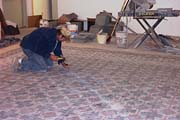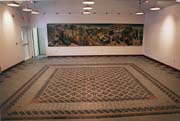
A new wing added last year to the Slate Valley Museum in Granville, NY, was built to display examples of the modern uses of slate. Stone artisan Jim Morris of Stoneage Rocksolid thought it was only fitting that the design for this addition reflect its purpose. With this idea in mind, Morris replicated an intricate English encaustic tile floor -- substituting the tile with natural slate quarried in the region.
“When Jim asked me what the museum had in mind for a design, I showed him a photograph of an ornate English encaustic tile floor in the historic Nott Memorial Building at Union College in Schenectady, NY,†said Museum Director Mary Lou Willits. “Never did I dream he would take me literally.â€
The mosaic pattern is encompassed by a border of mottled purple and green slate floor tiles engraved with names of individuals, businesses and community organizations who donated to the project. The slate was supplied by Camara Slate of Fair Haven, VT, and Ritchie Brothers Slate Co. and Sheldon Slate Products Co. Inc. of Middle Granville, NY.
“Jim masterfully combined all the slate colors of the valley -- red, green, purple, gray, black and mottled variations,†said Willits. “From a curatorial standpoint, it's a permanent exhibit and perfect complement to the museum's 24-foot WPA mural, Men Working in Slate Quarry, by Martha Levy, which hangs on the wall of the new wing.â€

Developing the idea
According to Morris, after seeing the photograph of the tile floor pattern, he began toying with the idea of recreating it with slate pieces. “Mary Lou really wanted something like that, but didn't think she could have it,†said the stone artisan. “When I got home, I started thinking about it. I took the design and came up with something similar.â€The floor area spans approximately 1,100 square feet, and a total of 3,740 pieces were implemented in the design, which measures 256 square feet. “I used all seven colors that we have in the valley,†said Morris. “The black, which came through Ritchie Brothers, is the only one from Pennsylvania.â€
All of the pieces were cut on site with a Felker wet saw and given beveled edges. “I really didn't have to cut the pieces on site, but the wing was for the modern use of slate,†explained Morris. “All of my floors are handcrafted. I decided to build this one on the spot, so that the museum can tell people that it was done right here.â€
With the entire theme being “The modern use of slate,†the outside border consisting of 12- x 12-inch tiles is meant to represent the old, and the mosaic pattern represents the use of new technology, according to Morris.
“It didn't take that long to complete,†he said. “It was about six weeks, and I only worked three hours a night. The longest part was cutting the pieces.†The slate pieces were installed with thinset from Tec Specialty Products and grout from Laticrete International.
One of the most challenging aspects of the project was keeping people out of the room while he worked, joked Morris. “As far as the work, though, trying to decide what colors to use where was the most difficult part,†he said. “I never realized before when you put colors in certain areas how it will look to a person.â€
The stone artisan explained that he drew the design out on paper first and shaded it in with crayons. “I graph everything out on paper,†he said. “It gives me an idea of the area that I'm covering and what's inside that area. By coloring, it allows me to see how it will exactly look.â€
The Slate Valley Museum was established to interpret the history of the slate industry along the Vermont and New York border. The new wing opened its doors to the public on April 12, 2003. “A year later, I still have people calling me specifically to say how beautiful it is,†said Morris.
End box
The floor of the new wing at the Slate Valley Museum in Granville, NY, was designed to replicate the look of an ornate English encaustic tile floor. The mosaic pattern was complemented by the museum's 24-foot WPA mural, Men Working in Slate Quarry, by Martha Levy, which hangs on the wall of the new wing.
The mosaic pattern -- designed and installed by Jim Morris of Stoneage Rocksolid -- skillfully incorporates all of the slate colors from the region, including red, green, purple, gray, black and mottled variations. The slate was supplied by Camara Slate of Fair Haven, VT, and Ritchie Brothers Slate Co. and Sheldon Slate Products Co. Inc. of Middle Granville, NY.
It took approximately six weeks to complete the project. “I only worked three hours a night,†said Morris. “The longest part was cutting the pieces.†The slate was installed with thinset from Tec Specialty Products and grout from Laticrete International.

End box:
Slate Valley Museum, Granville, NY
Stone Artisan / Installer: Stoneage Rocksolid, Granville, NYStone Suppliers: Camara Slate, Fair Haven, VT; Ritchie Brothers Slate Co., Middle Granville, NY; Sheldon Slate Products Co., Middle Granville, NY
Installation Products: Laticrete International, Bethany, CT (grout); Tec Specialty Products, Inc., Palatine, IL (thinset)
